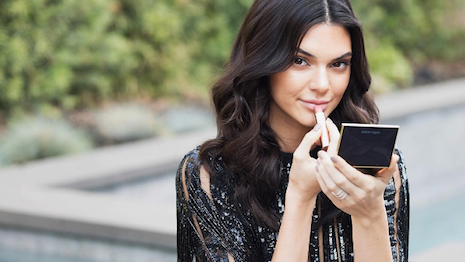 Kendall Jenner for Estée Lauder. Image credit: Estée Lauder
Kendall Jenner for Estée Lauder. Image credit: Estée Lauder
Creating highly satisfied customers is no longer enough for beauty brands, as labels should foster a relationship that develops more valuable connected consumers. During its "State of Social Media in the Beauty Industry 2017" webinar on Oct. 3, Shareablee laid out the impact that social media has had on the beauty business, where the brands that ignite passion in their customer base are separated from the ones that do not. The winners in this arena are finding ways to engage with the next generation of consumer through content such as tutorials and influencer posts. "This connected beauty consumer requires a massive shift..." said Tania Yuki, founder and CEO of Shareablee, New York. "Ads just no longer cut it—it requires community-driven content." Content creation On average, beauty brands are sharing 20 pieces of content per week. While their posting has only risen 12 percent this year, the engagement with these posts is up 36 percent. From January to August, there were 1.5 billion engagements with branded beauty content, whether shares, likes or comments. Despite only producing a 58 percent share of all beauty content, luxury brands receive eight out of 10 of all actions in the category. Activity is also concentrated among a group of four top dominant brands, including Kylie Cosmetics and Anastasia Beverly Hills, which collectively receive 80 percent of all engagements.
Since its launch in 2015, Kylie Jenner’s eponymous collection has taken the leadership position in social media engagement. In 2015, Anastasia Beverly Hills had a 79 percent share of Instagram beauty engagement, but the next year, Kylie Cosmetics boasted 81 percent of all beauty brand activity on the platform, showing how quickly change can happen. Across the board, makeup gets an overwhelming share of all engagement when compared to skincare and haircare. However, these other product types are growing their activity at faster rates. Compared to the average 59 percent of engagement that happens on Instagram in other categories, beauty sees 97 percent of its consumer activity on the platform. Indicative of Instagram's importance for beauty brands, last year, French atelier Christian Dior gave its beauty division a platform on the social network to boost the visibility of its personal care products.
Dior announced through its already established social channels that Dior Makeup had been given its own account on Instagram to segue an already active community to the new content page specific to cosmetics. Beauty products often fare the best on Instagram due to the visual nature of the platform, resulting in stronger interaction with the brand and items (see story). Shareablee found that after this specific community was established, Dior saw its makeup post engagement rise significantly. Video content production is up 61 percent on average across beauty brands, while engagement for video has risen 60 percent since the start of the year. Beauty brands have embraced new formats, such as live video, streaming content such as tutorials with personalities. For instance, French fashion label Yves Saint Laurent promoted some of its latest cosmetic products with a makeup masterclass hosted on Instagram Live. The class was hosted by YSL’s global beauty director Tom Pecheux, who instructed viewers on how to use the brand's cosmetics to achieve runway looks (see story). Connected consumer Shareablee sees Gen Z as more of a mindset than an age group, noting that 42 percent of digitally-driven consumers with a social profile are over the age of 40. One aspect of the new connected consumer that is changing the game is their dependence on peers to make buying decisions. Beyond their immediate social network, beauty labels can tap into this desire for word-of-mouth marketing by leveraging influencers and celebrities as spokespeople. Compared to the 1.5 billion total brand interactions, there were 6.4 billion engagements with influencer content, and influencers were behind 86 percent of the top 5,000 performing posts. While consumers do not want to be fed ads, about four in 10 will not complain about marketing if it is relevant to them. Beyond driving awareness, being on social media can provide marketers with the tools to turn inspiration into conversion. While not every buyer is going to engage with a brand they purchase on social media, a Shareablee study on consumer packaged goods brands found that those who buy more of something are more apt to engage on social media. Another engagement tactic that has proven effective is giveaways. While the return on these initiatives has fallen, these are still drivers of actions from consumers. Even though engagement is an important metric to strive for, loyalty is also important. "Awareness means nothing if people don’t keep the message top of mind and keep coming back to you," Shareablee's Ms. Yuki said.
